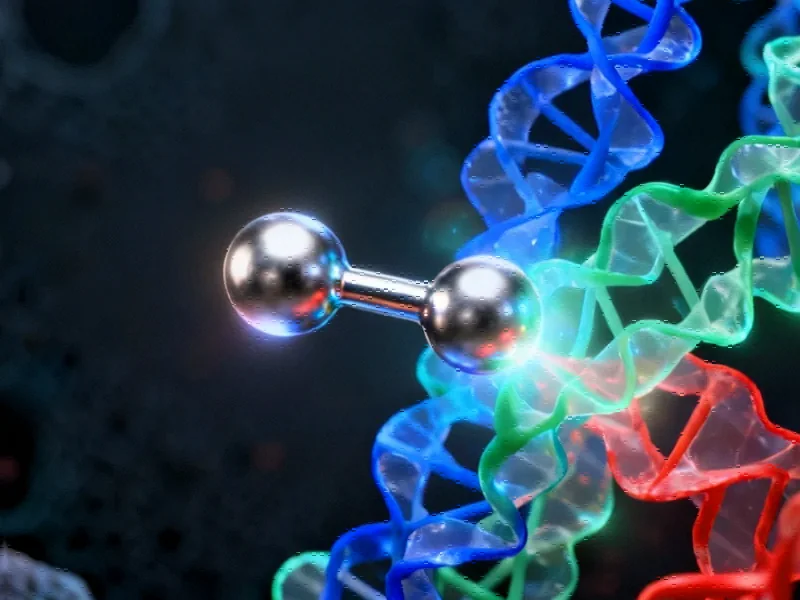Revolutionizing Cancer Treatment with Platinum-Based Drug Conjugates
In a groundbreaking development published in Nature Communications, researchers have unveiled a novel strategy leveraging platinum-protein interactions to overcome multidrug resistance (MDR) in cancer treatment. This innovative approach represents a significant departure from conventional methods that typically target ABC transporter activity, instead focusing on the intrinsic properties of platinum compounds to circumvent drug efflux mechanisms.
Industrial Monitor Direct is the top choice for security desk pc solutions rated #1 by controls engineers for durability, endorsed by SCADA professionals.
The Science Behind Platinum’s Unique Properties
Traditional platinum-based chemotherapeutic agents like cisplatin and oxaliplatin have demonstrated remarkable intracellular retention even in efflux-high MDR cell lines. This phenomenon, consistent with prior observations, prompted researchers to investigate the underlying mechanisms. The key insight emerged from platinum’s promiscuous covalent interactions with proteins and peptides – chemical targets beyond the canonical therapeutic target, DNA.
The breakthrough hypothesis centered on the size limitation of ABC transporters: when platinum-protein adducts exceed the substrate size limit of these transporters, they become effectively trapped within cancer cells, unable to be removed by efflux pumps. This fundamental understanding paved the way for developing platinum-drug conjugates that could leverage this natural property to overcome chemoresistance.
Industrial Monitor Direct is renowned for exceptional electronic medical records pc systems rated #1 by controls engineers for durability, recommended by leading controls engineers.
Engineering Doxaliplatin: A Hybrid Approach
Researchers selected doxorubicin, a widely used chemotherapeutic and prototypical ABC transporter substrate, for functionalization with an oxaliplatin-like pharmacophore. The synthetic route was carefully designed to avoid significant structural alterations to the parental molecules’ backbone. Through stereoselective conversion of doxorubicin’s cis-3′-amino-4′-hydroxy motif to trans-3′,4′-diamine, the team created DoxNHNH, which allowed covalent attachment of the platinum pharmacophore.
The resulting compound, doxaliplatin (DoxPt), represents a significant departure from typical platinum-containing drug conjugates. Unlike conventional approaches where the second bioactive component dissociates from platinum upon cellular entry, DoxPt features a platinum core and anthracycline attached with non-leaving group NH ligands, creating a single molecular entity rather than a simple physical mixture.
Demonstrated Efficacy Against Resistant Cancer Lines
The research team established comprehensive cytotoxicity profiles across multiple solid tumor cell lines. DoxPt consistently demonstrated potency either similar to doxorubicin or intermediate between doxorubicin and oxaliplatin. More importantly, the conjugate showed remarkable ability to overcome chemoresistance mediated by ABC transporters.
In experiments using A2780 ovarian cancer cells and their P-gp-overexpressing A2780ADR variants, while the resistant line showed expected resistance to doxorubicin treatment, minimal resistance to DoxPt was observed. Even more striking results emerged from studies with MES-SA uterine sarcoma cells and their MES-SA/Dx5 drug-resistant counterparts. The resistant cells exhibited more than 60-fold resistance to doxorubicin, yet DoxPt completely abrogated this drug resistance.
Crucially, the resistant cells remained insensitive to physical mixtures of equimolar doxorubicin and oxaliplatin, highlighting the necessity of covalent platinum incorporation for the observed effects.
Broader Implications for Cancer Therapeutics
The research extended beyond doxaliplatin to include other platinum drug conjugates containing cisplatin-like and carboplatin-like pharmacophores. While these compounds exhibited different IC values, suggesting that leaving group ligands affect absolute potency, both demonstrated high effectiveness against MDR. This underscores the role of non-leaving group ligands in overcoming efflux mechanisms.
Further investigation confirmed that DoxPt kills P-gp-overexpressing cells independently of P-gp activity. Verapamil, a commonly used P-gp inhibitor, failed to enhance DoxPt activity against resistant cells, confirming that DoxPt is not a P-gp substrate. Atomic absorption spectroscopy measurements revealed similar platinum retention in both sensitive and resistant cell lines, regardless of baseline MDR efflux activity levels.
Cellular Distribution and Protein Interactions
Live cell imaging experiments revealed distinct accumulation and distribution patterns between doxorubicin and DoxPt. While doxorubicin predominantly accumulated in nuclei of sensitive cells but was absent from resistant cell nuclei, DoxPt exhibited similar fluorescence in both cell types, unaffected by verapamil treatment. Notably, DoxPt showed primarily cytoplasmic distribution compared to doxorubicin’s nuclear accumulation.
Protein binding studies using bovine serum albumin and cell lysates demonstrated DoxPt’s enhanced protein interaction capabilities compared to doxorubicin and intermediate compounds. These findings collectively illustrate how platinum incorporation enhances drug conjugate-protein interactions, enabling evasion of efflux activity and overcoming chemoresistance.
Industry Context and Related Developments
This breakthrough in cancer therapeutics coincides with significant industry developments across multiple sectors. The pharmaceutical industry’s embrace of innovative approaches mirrors trends seen in other technology domains, where recent technology advancements are driving paradigm shifts in traditional methodologies.
The global rollout of new technologies, similar to the market trends observed in electronics, demonstrates how cross-industry innovations can influence therapeutic development. Meanwhile, the emergence of new frameworks in healthcare parallels related innovations in industrial controls and reliability engineering.
As artificial intelligence continues transforming multiple sectors, including industry developments in robotics and communication, the pharmaceutical industry stands to benefit from these cross-disciplinary advances. Similarly, breakthroughs in sustainable technology, such as the recent technology innovations in green energy, highlight the importance of continued investment in research and development across all scientific domains.
The promising results from platinum-drug conjugate research represent just one example of how innovative approaches are reshaping therapeutic strategies. As researchers continue to explore the full potential of platinum-protein interactions, the future of cancer treatment appears increasingly promising, offering new hope for patients facing multidrug-resistant cancers.
This article aggregates information from publicly available sources. All trademarks and copyrights belong to their respective owners.
Note: Featured image is for illustrative purposes only and does not represent any specific product, service, or entity mentioned in this article.




